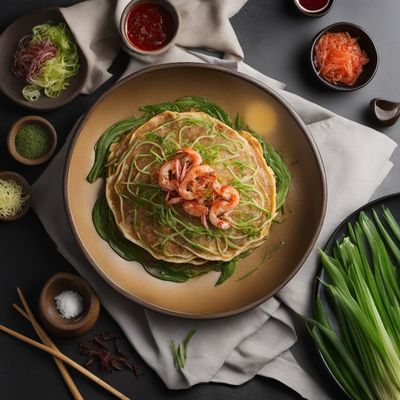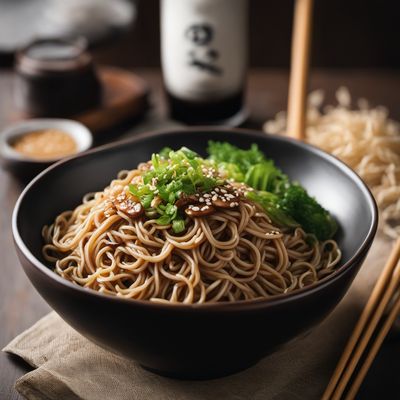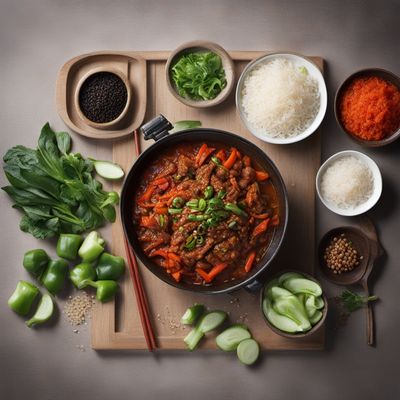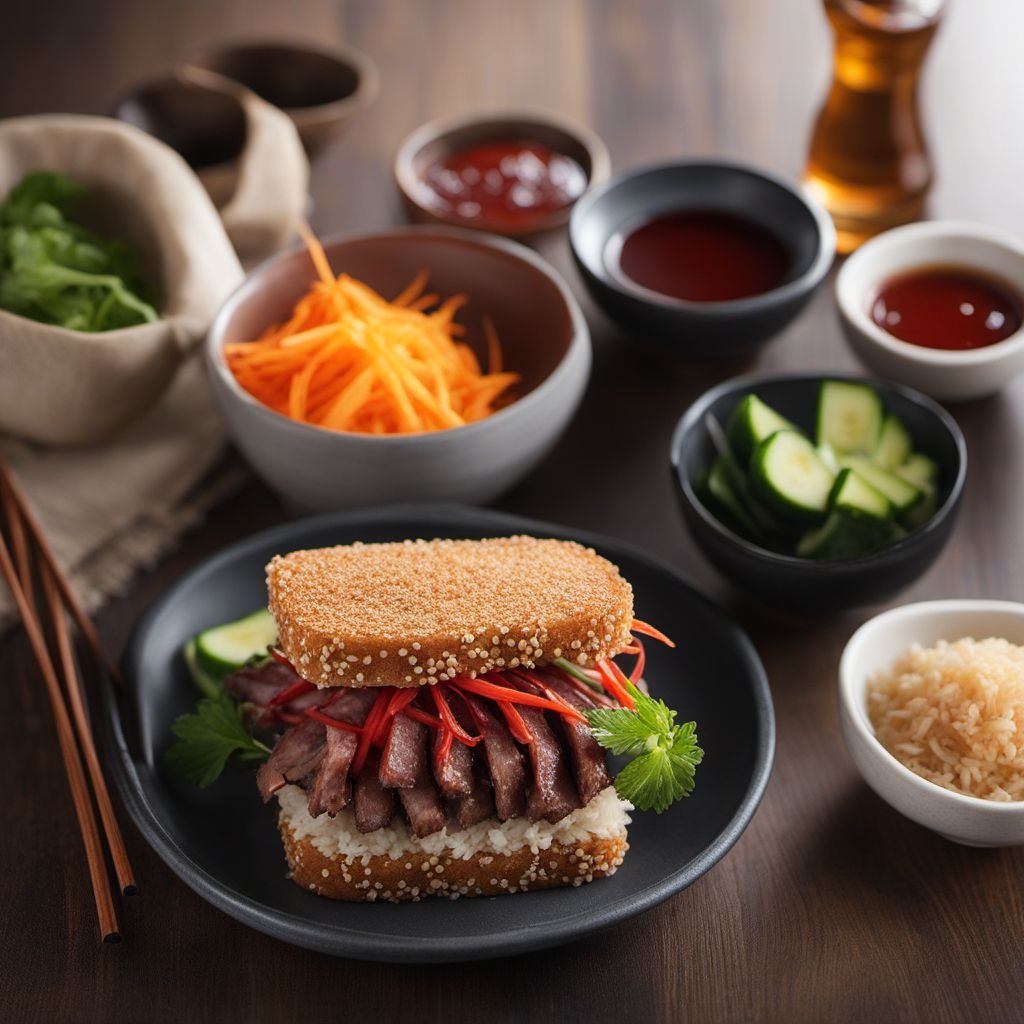
Recipe
Korean Chinese-style Wagyu Katsu Sando
Savory and Succulent Wagyu Katsu Sando with a Korean Chinese Twist
4.8 out of 5
Indulge in the flavors of Korean Chinese cuisine with this delectable twist on the classic Japanese Wagyu Katsu Sando. This recipe combines the tenderness of Wagyu beef, the crispiness of panko breadcrumbs, and the umami-rich flavors of Korean Chinese cuisine, resulting in a mouthwatering sandwich that will leave you craving for more.
Metadata
Preparation time
30 minutes
Cooking time
10 minutes
Total time
40 minutes
Yields
2 servings
Preparation difficulty
Medium
Suitable for
Omnivore, Low carb, High protein, Dairy-free, Nut-free
Allergens
Wheat (from bread and breadcrumbs), Eggs, Soy
Not suitable for
Vegetarian, Vegan, Gluten-free, Paleo, Keto
Ingredients
In this Korean Chinese adaptation of the Wagyu Katsu Sando, we incorporate the bold and savory flavors of Korean Chinese cuisine. The original Japanese version typically uses tonkatsu sauce, while our recipe features a tangy and savory Korean Chinese sauce. Additionally, we serve the sandwich with pickled vegetables, a common accompaniment in Korean Chinese cuisine, to add a refreshing and tangy element to the dish. We alse have the original recipe for Wagyu katsu sando, so you can check it out.
-
4 slices of milk bread 4 slices of milk bread
-
400g (14 oz) Wagyu beef cutlets 400g (14 oz) Wagyu beef cutlets
-
1 cup (120g) all-purpose flour 1 cup (120g) all-purpose flour
-
2 large eggs, beaten 2 large eggs, beaten
-
2 cups (200g) panko breadcrumbs 2 cups (200g) panko breadcrumbs
-
Vegetable oil, for frying Vegetable oil, for frying
-
Salt and pepper, to taste Salt and pepper, to taste
-
For the Korean Chinese sauce: For the Korean Chinese sauce:
-
3 tablespoons soy sauce 3 tablespoons soy sauce
-
2 tablespoons rice vinegar 2 tablespoons rice vinegar
-
1 tablespoon honey 1 tablespoon honey
-
1 tablespoon gochujang (Korean chili paste) 1 tablespoon gochujang (Korean chili paste)
-
1 teaspoon sesame oil 1 teaspoon sesame oil
-
2 cloves garlic, minced 2 cloves garlic, minced
-
1 teaspoon grated ginger 1 teaspoon grated ginger
-
For the pickled vegetables: For the pickled vegetables:
-
1 carrot, julienned 1 carrot, julienned
-
1 cucumber, julienned 1 cucumber, julienned
-
1/4 cup rice vinegar 1/4 cup rice vinegar
-
1 tablespoon sugar 1 tablespoon sugar
-
1/2 teaspoon salt 1/2 teaspoon salt
Nutrition
- Calories (kcal / KJ): 650 kcal / 2720 KJ
- Fat (total, saturated): 32g, 8g
- Carbohydrates (total, sugars): 50g, 8g
- Protein: 40g
- Fiber: 3g
- Salt: 2g
Preparation
-
1.Preheat the vegetable oil in a deep pan or skillet over medium heat.
-
2.Season the Wagyu beef cutlets with salt and pepper on both sides.
-
3.Dredge each cutlet in flour, shaking off any excess.
-
4.Dip the cutlets into the beaten eggs, allowing any excess to drip off.
-
5.Coat the cutlets in panko breadcrumbs, pressing gently to adhere.
-
6.Fry the cutlets in the preheated oil until golden brown and crispy, about 3-4 minutes per side. Transfer to a paper towel-lined plate to drain excess oil.
-
7.In a small bowl, whisk together all the ingredients for the Korean Chinese sauce until well combined.
-
8.In a separate bowl, combine the julienned carrot, cucumber, rice vinegar, sugar, and salt. Let it sit for 10 minutes to pickle.
-
9.To assemble the sandwich, spread a generous amount of the Korean Chinese sauce on one side of each slice of milk bread.
-
10.Place a Wagyu beef cutlet on one slice of bread and top with pickled vegetables. Cover with another slice of bread.
-
11.Repeat the process to make the second sandwich.
-
12.Slice each sandwich in half and serve immediately.
Treat your ingredients with care...
- Wagyu beef cutlets — Make sure to bring the beef to room temperature before cooking to ensure even cooking and a tender result.
- Panko breadcrumbs — For extra crispiness, lightly toast the panko breadcrumbs in a dry skillet before using them in the recipe.
- Gochujang — Adjust the amount of gochujang according to your spice preference. Add more for a spicier sauce or reduce for a milder flavor.
Tips & Tricks
- For an extra layer of flavor, add a thin layer of Japanese mayonnaise to the bread before spreading the Korean Chinese sauce.
- If you can't find Wagyu beef, you can substitute it with another tender cut of beef, such as ribeye or sirloin.
- To make the sandwich even more indulgent, consider adding a slice of melted cheese on top of the beef cutlet.
- Experiment with different pickled vegetables, such as radishes or daikon, to add variety to the sandwich.
- Serve the sandwich with a side of sweet potato fries for a satisfying meal.
Serving advice
Serve the Korean Chinese-style Wagyu Katsu Sando as a main course for lunch or dinner. Cut each sandwich in half diagonally for an elegant presentation. Accompany it with a side of pickled vegetables and sweet potato fries for a complete and satisfying meal.
Presentation advice
To enhance the presentation, you can garnish the plate with a sprinkle of sesame seeds and finely chopped green onions. Serve the sandwich on a wooden cutting board or a stylish plate to showcase its appetizing appearance.
More recipes...
For Wagyu katsu sando
For Japanese cuisine » Browse all
More Japanese cuisine dishes » Browse all

Tori katsu
Chicken Katsu
Tori katsu is a Japanese dish made with breaded and deep-fried chicken cutlets. It is a popular dish in Japan and is often served with rice and miso soup.

Tebasaki yakitori
Chicken Wing Yakitori
Tebasaki yakitori is a Japanese dish made with chicken wings skewered and grilled over charcoal. It is a popular street food in Japan and is often...
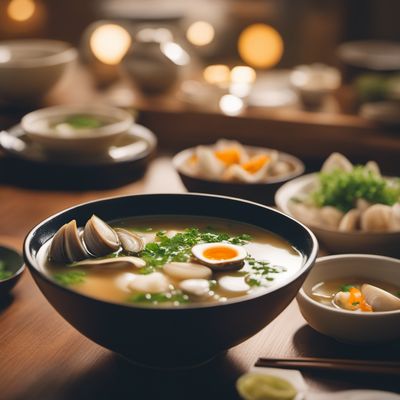
Sumashijiru
Miso soup with clams
Sumashijiru is a traditional Japanese soup that is made with fish, vegetables, and tofu. It is a light and healthy soup that is perfect for a...



